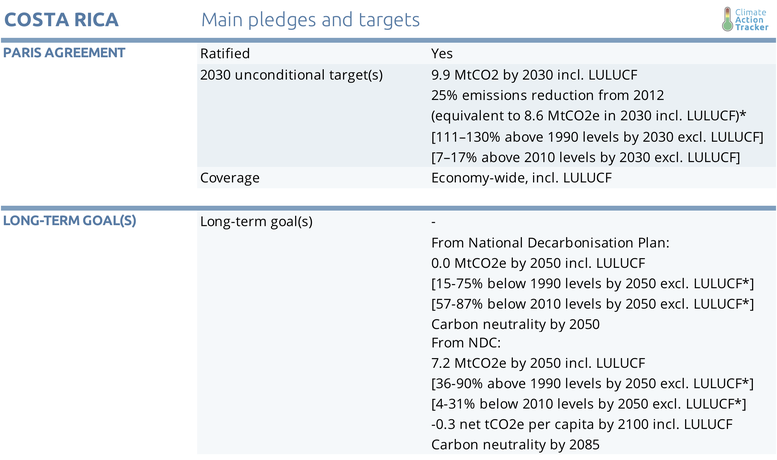Country summary
Overview
In February 2019, Costa Rica outlined its pathway towards net-zero emissions by 2050 in a new plan: the National Decarbonisation Plan 2018-2050. This new 2050 target represents an improvement on its current 2050 Paris Agreement target, and is very close to our “1.5 Paris Agreement compatible” range.
The National Decarbonisation Plan includes strategies for all sectors of the economy, which, if implemented, will lead to further emissions reductions The strategies include electrifying the public transport system, energy efficiency measures in industry, transport (incl. freight), and buildings sectors, and improved farming practices and measures in the waste and agriculture sectors. . If Costa Rica implements all of its planned policies under this plan this would result in a pathway very close to our 1.5°C range.
The National Decarbonisation Plan is more ambitious than Costa Rica’s Paris Agreement targets for 2030 and 2050. The government plans to present an updated Nationally Determined Contribution (NDC) in 2020, which is expected to be informed by the new plan, as well as other climate policy planning documents, including the National Strategic 2050 plan.
If Costa Rica were to update their NDC in line with this new National Decarbonisation Plan, it would fall very close to our 1.5°C compatible range.

Costa Rica has had high aims on climate for the last ten years, but its policies are still catching up. According to our analysis, under a pathway following its current NDC commitments, Costa Rica would only achieve carbon neutrality in 2085. However, if Costa Rica were to implement all the new policies in its new Decarbonisation Plan, it could achieve carbon neutrality 35 years earlier, i.e. by 2050. For full details see pledges and targets section.

Costa Rica is close to achieving its 2030 NDC emissions reduction target due to new policies that support the electrification of its transport sector, the country’s largest source of greenhouse gas (GHG) emissions. This includes a law to promote and incentivise transport electrification - all from renewable energy, and made it a national priority to use renewable energy in all modes of transportation including trains, freight, buses, and taxis. The new National Plan for Electric Transportation, published in early 2019, contains a set of strategic actions, the plan for implementation. It establishes that the bus fleet should be replaced by electric buses every two years by at least 5%, and at least 10% of new taxis concessions are given to electric vehicles, between other measures
Successful implementation of this policy would lead to a 2030 emissions reduction equivalent to 19% of GHG reductions compared to a pathway without this policy.
Costa Rica has launched multiple initiatives to facilitate the implementation of its NDC. Its climate-related policies and programmes include the second phase of its National Programme for Carbon Neutrality—a carbon neutral certification scheme for businesses and municipalities, Nationally Appropriate Mitigation Actions in the agricultural sector, and the National Energy Plan.
In February 2019 Costa Rica extended its moratorium on oil extraction and exploitation from 2021 until the end of 2050.
Costa Rica’s electricity generation already runs on a very high share of renewable sources, and aims to be 100% renewable by 2021. In 2018 the country beat its own record by generating 98% of electricity from renewable sources - for the fourth consecutive year.
Further analysis
Latest publications
Stay informed
Subscribe to our newsletter




